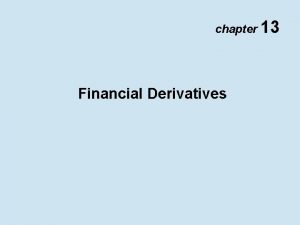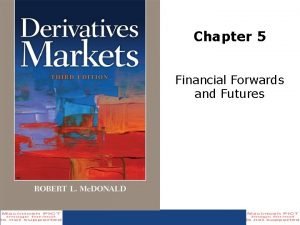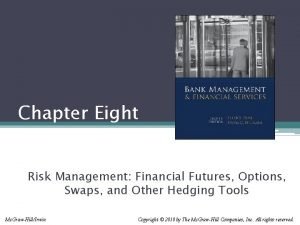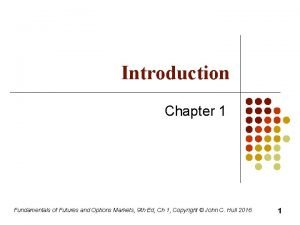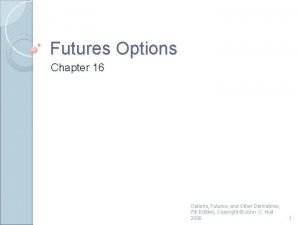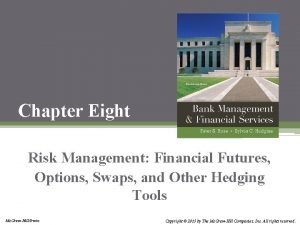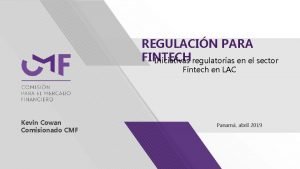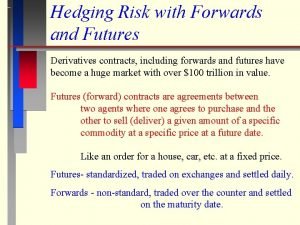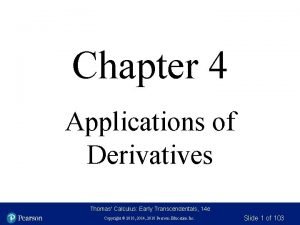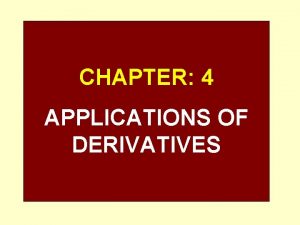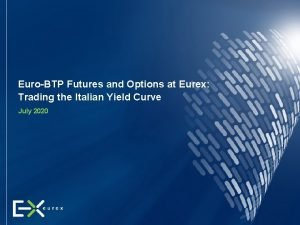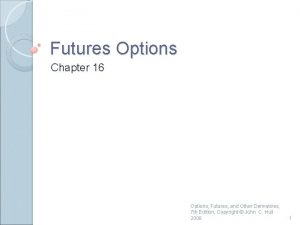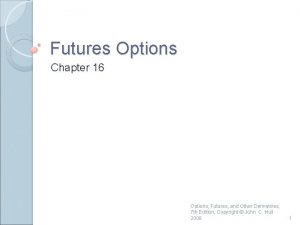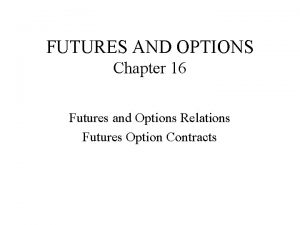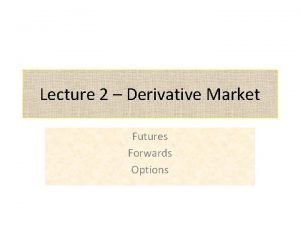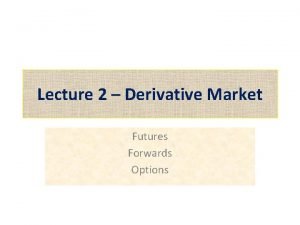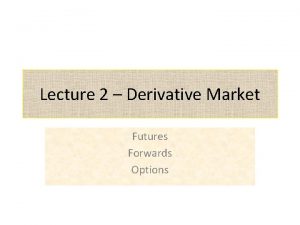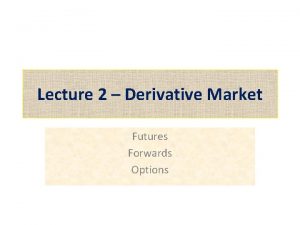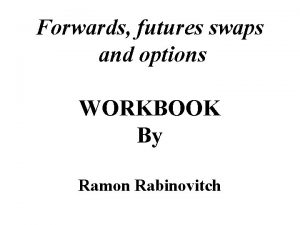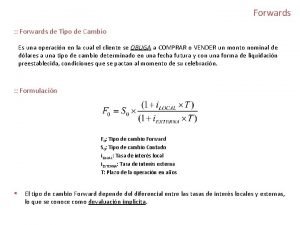Fintech Chapter 12 Options Derivatives Linear Futures Forwards

























- Slides: 25

Fintech Chapter 12: Options

Derivatives • Linear- Futures, Forwards, Swaps • Non-linear- Insurance aspect: CDS, Options

Options • Options grant the buyer or long, the right but not the obligation to own the underlying asset at a specified or “strike” price • For this right, the buyer pays a fee or “premium” • The seller or short is under the obligation to sell the underlying asset at the strike price if the buyer so desires. • In return for being required to sell at what might be a below current market price, the seller of the option collects a fee or “premium

Options are traded on many financial assets: • Equities • Equity indexes • Bonds • Currencies • Commodities • Futures

Options • Call option: gives the buyer the right to own or go long the underlying asset • Put option: gives the buyer the right to sell or go short the underlying asset

Options Four basic option strategies: • Long call • Short call • Long put • Short put More complex option strategies are a result of combining two or more of these four basic positions.

Options Option name: • Underlying issue • Expiry Date • Put or Call • Strike Price Example: SQ September 2018 Call $0. 95

Options Exchange traded options: terms specified by the Exchange • Equity options on CBOE, NYSE, Nasdaq • Monthly, quarterly and longer dated • Energy options on NYMEX and ICE • OTC: customized terms

Options When can buyer exercise their option rights? • American options: at any time during the life of the options • European options: exercisable only at expiry

Options are “in the money”, “at the money”, or “out of the money”. • At-the-money options have a strike price equal to the current underlying asset price. • A call option is in-the-money if the strike price is below the current asset price • A put option is in-the-money if the strike price is above the current asset price. • A call option is out-of-the-money if the strike price is above the current asset price; • A put option is out-of-the-money if the strike price is below the current asset price.

Options Risks in trading options: • Option buyers risk losing the amount of premium paid • Call sellers risk being short in a rising market, theoretically unlimited • Put sellers risk being long in a falling market. Their risk would be the total of the strike price minus the premium received.

Options Figure 12. 1 Long Call Net Position at Expiry Long XYZ 60 call Maximum Gain: Unlimited Maximum Loss: Premium paid

Options Figure 12. 2 Long Put Net Position at Expiry Long XYZ 60 put Maximum Gain: Strike price – premium paid Maximum Loss: Premium paid

Options Figure 12. 3 Short Call Net Position at Expiry Short XYZ 60 call Maximum Gain: Premium received Maximum Loss: Unlimited

Options Figure 12. 4 Short Put Net Position at Expiry Short XYZ 60 put Maximum Gain: Premium received Maximum Loss: Strike price – premium received (substantial)

Options Advanced option strategies: • Covered call: own a stock, sell a call. • Investor owns stock, collects any dividend, and collects option premium. • The covered call doesn’t have the same unlimited risk as the short call alone. The investor can deliver the underlying stock if call is exercised. • Investor still has risk to the downside on the original equity position, but call premium provides a (modest) cushion

Options Advanced option strategies: • Vertical call spread (also called a “bull” or “debit” call spread). Here, the investor buys a lower strike call and sells a second higher strike call. • For example, the investor might buy XYZ 60 call and sell XYZ 65 call. If the price of XYZ at expiry is above 60, the investor exercises the long 60 call and is increasingly profitable until XYZ is valued at 65. • The investor’s risk is limited to loss of the net premium paid for the strategy.

Options Advanced option strategies: • Vertical put spread. This is the mirror image of the vertical call spread. In this strategy, the investor wants some coverage to the bearish side of the market. In our example, the investor might buy the XYZ 60 put and sell the XYZ 55 put. • As the market trades lower, at expiry, the 60 put goes in the money and the strategy begins to be profitable. At 55, the investor can be expected to be assigned a long position which would offset the short acquired at 60.

Options Advanced option strategies: • Collar (or Cap and Floor). In this strategy, options are used to protect a range. An investor long an equity might wish to buy a put to protect against the downside. They might also wish to offset some of the cost of the put by being willing to sell the equity at a price above the current market price. This can be accomplished by selling a call. • The combination of the long put and short call establishes a floor and cap, or collar on the position. In our example, with XYZ currently trading at 60, the investor could buy the 55 put and sell the 65 call.

Options Advanced option strategies: • View of market direction: • Going higher: • Long call • Short put • Long call spread • Short put spread • Going lower: • Short call • Long put • Short call spreads • Long put spreads

Options Advanced option strategies: • Increased volatility, but not sure of market direction • Greater volatility • Buy straddle • Buy strangle • Lesser volatility • Sell straddle • Sell strangle • Long Straddle. The long straddle consists of both a long call and a long put, at the same strike price. • Long Strangle. Similar to straddle, but the put strike is lower than the call strike.

Options Figure 12. 5 Long Straddle Net Position at Expiry Long 1 XYZ 60 call Long 1 XYZ 60 put Maximum Gain: Unlimited to the upside. Strike price – total premia to the downside Maximum Loss: Total premia paid

Options Option Pricing There are six factors that influence the pricing of options. They are: • Strike price of the option • Price of the underlying asset at the current time • Interest rate • Time to expiry of the option • Volatility in the price of the underlying asset • Dividend that might be expected from the underlying asset

Options The Black-Scholes-Merton and other models are used to develop theoretical option prices. Changes in the above factors are seen to each have an impact on option pricing, and a convention has been developed of referring to some of these incremental impacts by the following Greek letters: • Delta refers to the sensitivity of an option’s theoretical value to a change in the price of the underlying asset • Gamma refers to the change in delta for a change in the underlying price • Vega is a measure of the sensitivity of the option value to changes in volatility • Theta is a measure of time decay, the change in the option’s value over time • Rho is a measure of the sensitivity of the option value to changes in interest rates

Options Fintech Applications in Options • AI for pricing and trading of options • Blockchain in post-trade processing
 Advantages and disadvantages of derivatives
Advantages and disadvantages of derivatives Options futures and other derivatives
Options futures and other derivatives Synthetic forward contract
Synthetic forward contract Options futures and risk management
Options futures and risk management Introduction to futures and options
Introduction to futures and options Futures style options
Futures style options Traders in financial futures
Traders in financial futures Currency futures
Currency futures Hedging strategies using futures and options
Hedging strategies using futures and options Fintech center korea
Fintech center korea Bermuda fintech
Bermuda fintech Fintech lac
Fintech lac Fx forwards manchester
Fx forwards manchester Hedging in forward market
Hedging in forward market Equity forward price
Equity forward price Mercados de forwards y swaps
Mercados de forwards y swaps A bottle of rum to fill my tum
A bottle of rum to fill my tum Hedge ratio formula
Hedge ratio formula Chapter 4 applications of derivatives
Chapter 4 applications of derivatives Chapter 4 applications of derivatives
Chapter 4 applications of derivatives Chapter 3 food service career options worksheet answers
Chapter 3 food service career options worksheet answers 005930 bandingkan
005930 bandingkan Futures price formula
Futures price formula Interest rate futures
Interest rate futures Euro btp futures
Euro btp futures Normal backwardation
Normal backwardation
